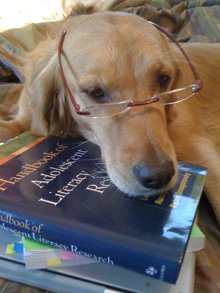 |
Muffin is a therapy dog,
specializing in reading assistance. |
I became interested in using therapy dogs to motivate reluctant readers after I adopted a sweet, timid Golden Retriever named Muffin. Although everyone knows that kids and dogs are a winning combination I (as a former teacher of English and professor of teacher education specializing in literacy development) initially expressed skepticism that dogs trained to assist children with reading could help them become better readers. But then I learned about research-based international organizations, such as Reading Education Assistance Dogs program for registered therapy dogs.
The goal of programs like R.E.A.D. is to improve children's reading and communication skills by having a child read to a dog. R.E.A.D. dogs are registered therapy animals who, along with their owner/handlers, volunteer at schools, libraries, and many other settings as reading companions for children. As a literacy instructor, I was particularly heartened to learn that for the specialized reading certification, the handler/pet partner must demonstrate knowledge of general literacy tutoring skills and how to support young readers, including English Learners.
Emerging Research on Reading Dogs
I still found myself, like most teachers, looking for results, especially in light of the 2007 NAEP reading scores indicating only a slight rise in fourth and eighth grade scores since 1992, despite all the attention on literacy.
The Delta Society, an internationally recognized therapy animal association, cites the research of Robert H. Poresky and Karen Allen that children’s cognitive development can be enhanced through pet ownership and that just the presence of a dog can lower the blood pressure of children reading aloud. Delta also published the results of a pilot study of 10 children at Bennion Elementary in Salt Lake City in 2002 who participating in the R.E.A.D. program revealing that children increased their reading comprehension and skills as much as two to four grade levels in one year.
Until recently, studies of reading dog programs with significant numbers have been unavailable because such programs are designed to have one child read with one animal. However, several UC Davis researchers, in collaboration with the Tony La Russa Animal Rescue Society of Walnut Creek, conducted two studies with the All Ears Reading program of third graders in California and Washington. The study confirmed that children who regularly read to dogs significantly improve their reading scores. Over 10 weeks of reading once a week to a dog, participants improved their reading skills of fluency and accuracy by 12 percent over the control group which showed no improvement, according to a report in The Sacramento Bee. Studies like this support anecdotal claims that through reading with the assistance of animals children raise self-esteem, build confidence and improve reading skills.
Muffin’s Story
Although she is now a certified R.E.A.D. dog, my dog Muffin was a rescue dog. When she arrived in my home she was timid, fearful of most things, and reluctant to trust anyone. It took time, patience, and a lot of repeated positive experiences to build her confidence. When she became a reading dog, I thought that hearing about Muffin’s new-won confidence might be valuable to share with children who were reluctant readers as many children are reluctant to read for fear of ridicule or lack confidence or motivation.
I decided to put together a book about Muffin for children to read. My idea was that Muffin’s book would feature pictures of her with sentences describing her actions and activities. That way, children could get to know the dog and her story, and then maybe want to share a little bit about themselves. I hoped they would begin to feel comfortable enough to want to read to her. Teachers of reading know that students during the pre-reading stage need to develop purpose, motivation, and background knowledge about the subject matter of the text, as stated by researchers Suzanne F. Peregoy and Owen F. Boyle. For many a child there is no better motivation to read than doing so while reading a book about the dog you are petting.
In the spirit of wanting the book to be really inviting, I selected a purple cover with Muffin’s picture on the front. I picked out her best glossy pictures and each page had a picture and a caption with a sentence or two about Muffin. Some of the pictures were about her liking to hike or learning to swim. Some of the pictures had her dressed up for Halloween or sporting a sun hat in the summer. Some were funny and some were serious, but each of the pictures provided an opportunity for us to share a little bit about Muffin and get to know the children who were snuggling up beside her.
Muffin’s book was finished in just enough time for the local community library-sponsored R.E.A.D. event at the children’s library. On the day of the event, I packed a purple blanket for kids to sit on and her new book with the purple cover. I tied her bright red reading dog scarf around her neck. When we arrived at the library, the room was filled with kids and other reading dogs. Each child received an age-appropriate dog themed book and was assigned a canine reading partner/handler. I really had no idea what to expect.
After our first couple of sessions, a pattern began to emerge. Muffin curled up on a bench and each child curled up right with her. When I asked them if they wanted to read a book about her, they remarked: “Could we read Muffin’s book again?” or “Muffin has a friend named Chloe—that’s my name!”
When a 12-year old reader saw the picture with the caption, “Muffin is learning to swim,” the comical-yet-fearful look on Muffin’s face caused her to share some fears of her own. “Was Muffin scared when she learned to swim?” she asked. She then offered up, unprompted, “I was scared when I was in the hospital. I was there for a year, but now my cancer’s in remission. I wanted to read to a dog today because there was a dog who came to visit a lot when I was in the hospital.” And read she did, an entire book about a service dog—including the acknowledgements.
Dogs Serve to Motivate
It was clear that Muffin’s book had the intended effect. About 10 different children waited in line to read to Muffin over the course of our two-hour visit. All the while she was hugged, petted, stroked, and fussed over.
Although I may have been somewhat of a skeptic at first, I can say now with confidence that a dog can be an incredible motivator for a child who is learning to read. Although I realize not all students have experienced the adversity of illness or feel passionate about animals, reading to a dog can offer a non-judgmental, safe place for children to practice their reading skills in a fun environment. These days Muffin is always in demand at libraries and classrooms, even with the most reluctant readers. To date, there are over 2,000 trained therapy teams in more than 49 states. Find out if there’s such a program near you.
 Dr. Deborah G. Summers, Ed.D. is a professor of secondary adolescent literacy, the director of the School of Education at California State University, Chico and the co-author of Socially Responsible Literacy: Teaching Adolescents for Purpose and Power (2014, Teachers College Press). A secondary classroom teacher for 15 years, her research interests focus on the ways literacy practices help adolescents to become full participants in a pluralistic society.
Dr. Deborah G. Summers, Ed.D. is a professor of secondary adolescent literacy, the director of the School of Education at California State University, Chico and the co-author of Socially Responsible Literacy: Teaching Adolescents for Purpose and Power (2014, Teachers College Press). A secondary classroom teacher for 15 years, her research interests focus on the ways literacy practices help adolescents to become full participants in a pluralistic society.